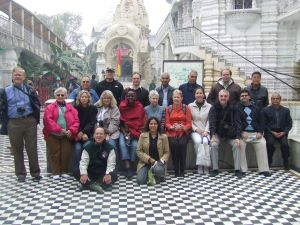Associate Professor of Business Administration Fred Hoyt was selected to participate in a Faculty Development in International Business Program in New Delhi, India. The program, sponsored by the University of Connecticut’s Center for Business Research, provided participants with information about the Indian economic system, plus opportunities to tour businesses and visit government officials.
January 5, 2008
Believe it or not, I’m probably close to where you might reach if you started digging in Bloomington-Normal, and cut through the earth; I’m on the other side of the world and digging the earth might be easier than sitting for 14 hours in the plane (Chicago to New Delhi), arriving here around midnight India time. We’re 11 1/2 hours different (India would be 1/2 hour different!) than central Illinois.
The last time I was here, I brought students around the world. India was our second stop, and we came from London. As I recall that May 2001 day, the temperature was 100 degrees at 3000 feet–at midnight–just before the monitor cut off. Last night (have I been here only 24 hours?), it was 45 degrees. India is, as that example shows, a land of contrast.
 I’m at the Management Development Institute with about 20 other faculty, to learn about the new India. We’re staying in a hostel that is sort of like camp–fairly spartan quarters, but quite satisfactory. At least the outhouse is in the room! The Institute is one of the top four business schools in India, and we’ll have a chance to meet with people in our area, tour factories and historic sites, and eat some great Indian food in the restaurant in the dorm.
I’m at the Management Development Institute with about 20 other faculty, to learn about the new India. We’re staying in a hostel that is sort of like camp–fairly spartan quarters, but quite satisfactory. At least the outhouse is in the room! The Institute is one of the top four business schools in India, and we’ll have a chance to meet with people in our area, tour factories and historic sites, and eat some great Indian food in the restaurant in the dorm.
Today was a relatively easy day. I was up early, finished a book I’d brought along, and went for a walk with a University of Wisconsin professor who happened to be up early, too. He’s Indian by birth, and speaks Hindi, which was a real advantage because it’s pretty obvious I’m from out of town. After getting acquainted with our hosts and each other (there’re faculty from both coasts, and a variety of business disciplines, and one political scientist), we went on a tour of the national museum.
I can’t help coming to India and comparing it to my recollections of the past (I was here in 97, 01, and now) and to China.
Compared to the last time I was here, there seems to be a lot more construction. It’s sort of like what I remembered China was 10-15 years ago. The two lane roads in Delhi are being replaced by superhighways (I thought our bus was going really slow; but I saw the speed limit for busses was only 40 km, or about 25 miles per hour), and the housing is gradually being replaced by high rises. The contrast between rich and  poor is still there–families live in shanties (I think that’s an Indian word) outside gated communities, with the middle class (probably larger in the big cities, and certainly here in the nation’s capital) shopping at the new and quite large malls. We passed one that boasted at least 1km of shopping on each floor, or roughly a half mile! The chaos in the street (the Brahmin cows are wandering about, with motorcycles, bikes, trucks, busses, and increasing numbers of new cars, jockeying for space) is much the same.
poor is still there–families live in shanties (I think that’s an Indian word) outside gated communities, with the middle class (probably larger in the big cities, and certainly here in the nation’s capital) shopping at the new and quite large malls. We passed one that boasted at least 1km of shopping on each floor, or roughly a half mile! The chaos in the street (the Brahmin cows are wandering about, with motorcycles, bikes, trucks, busses, and increasing numbers of new cars, jockeying for space) is much the same.
We tour tomorrow too, and I’m eager to see once again the vestiges of Mughal rule (Muslims from Afghanistan, I believe, invaded and conquered India, before the British and there was a Mughal ruler until the 1850s) in the center of the old city. Perhaps since it’s formerly a British colony (the football scores here are Royale Madrid 1, Arsenal 0, which should tell you something about football!), I should spell it centre.
More when I get a chance, but my best to you all.